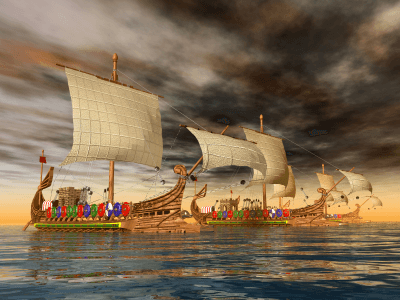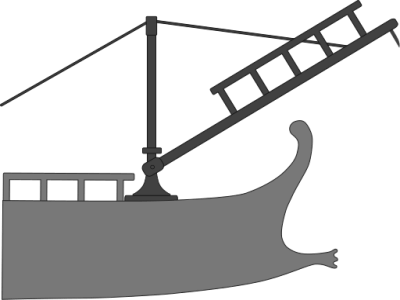The Roman Navy

Prior to the Punic Wars, the Roman classis (Latin meaning 'fleet') was limited to minor coastal operations and support for trade.
The Romans primarily concentrated on land-based operations until this period in order to conquer and consolidate the Italian peninsula (Italia).
With Rome being located roughly in the center of Italia, coupled with the speed of ships back then and the administrative hassle of assembling a large fleet, Roman commanders preferred to simply march their troops to their destination rather than sail them there.
The wars with Carthage forced the Romans to adapt to naval operations in order to compete and defend.
During the First Punic War a large fleet was built, allegedly using a stranded Phoenician vessel as a prototype.
The Romans lacked the skill of other maritime powers such as the Greeks and Carthaginians and had to resort to technology for advantages, such as the introduction of the corvus, which is discussed later on in this article.
Roman Ships
The relative calm of the Mediterranean Sea was not ideally suited to sails and wind power, and so fighting boats of the civilizations of the region relied on people power in the form of oars and rowing. Not only did this ensure a steady source of propulsion, but also made the boats highly maneuverable.
By the 3rd centrury BC, these boats had evolved into substantial vessels.
The trireme consisted of three rows of oarsmen, one above the other, with each row having a different length of oar to be able to reach the water and avoid clashes with the row above or below. With around 85 men on each side, it is estimated that these ships could possibly reach speeds of up to 8mph with all that muscle power!
There were downsides of course.
Whilst movement could start at a single command, unlike relying on wind power which is unreliable, it did also mean the ship could only move as far as the rowers could take it until they became exhausted.
The size was also limited, as a bigger ship would need even more men to row, who would take up more space, which would need a bigger ship etc.
There was nowhere near enough space on board to accommodate all those men when they needed to rest, which meant that ships had to be beached if the whole crew was to get a break. For this reason, triremes never ventured too far from the shore.
Weapons
This period of history was long before the invention of gunpowder and cannons. Even if they had been available, the lack of space and extra weight would not have been suitable for a vessel that was rowed.
The primary weapon and tactic of these types of boats was ramming. A crude yet effective method of attack, it simply involved the rowers propelling the ship as fast as they could towards an enemy boat, where the end of a ram located at the front would strike the fragile hull below the waterline in the hope of sinking it.
Despite ramming being a rather simple form of attack, the Romans still struggled in naval battles when coming up against opponents that had much more experience in this form of naval warfare than they did.
They quickly realized that they needed to find an edge if they were to overcome their rivals.
The Corvus – Taking Hand-to-Hand Combat to The Sea
One of the key strengths of the Romans was their ability to adapt and improve on the technology and tactics of their rivals, as well as focusing on what they were already good at.
Although the traditional naval tactic of ramming wasn't abandoned, around the 3rd century BC Roman ships were fitted with a corvus to accommodate their strengths in land combat.
This boarding bridge rotated around a pole and, thanks to a heavy spike on the end, attached firmly to the deck of an enemy ship.
Once attached, Roman soldiers swarmed across and engaged in hand-to-hand combat with their enemies, which was a form of fighting they were much more comfortable and experienced in.
The introduction of the corvus enabled the Romans to transform naval combat from ramming and sinking, to boarding with marines. Not only did it provide them with victory, but it also allowed them to plunder anything of value and capture the boat for their own use rather than simply sinking it.
In its initial stages, this new combat style enabled the Romans to win some overwhelming successes against the Carthaginian fleet, such as at Mylae off the coast of Sicily in 260 BC.
The corvus was not without issues, however. The added weight of the corvus made their vessels less maneuverable and seaworthy. The weight affected the center of gravity of the boats, making them prone to capsizing in rough seas. During the invasion of Africa (see below), the Romans lost many ships to storms.
The Decline of Roman Naval Power
Victory bred confidence and led to the eventual invasion of North Africa.
Their newly acquired sea prowess enabled the Roman legions of the Republican Period to land on the coast of North Africa and bring the war out of Italy and into the laps of the Carthaginians.
Their navy became so successful in fact, that Hannibal, in the Second Punic War, abandoned the once formidable Carthaginian fleet to focus on land operations.
With the final destruction of Carthage, and the end of the Third Punic War in 146 BC, Rome was the master of sea power in the Mediterranean.
After building up such a formidable naval fleet, the conquest of Carthage actually ended up virtually eliminating the threat of maritime warfare, as there were simply no longer any sea powers left to challenge Roman supremacy.
As a result, the navy slipped into the logistical role of support to the legions and providing escort for trade vessels and grain shipments, with the adverse effect of drastically increasing piracy.
The only significant naval occurrences, aside from Caesar's crossing to Britannia, for the remainder of the Republic came during the Civil Wars that would end the current system. The battle of Actium, between Octavian's Legate Marcus Vipsanius Agrippa and the combined forces of Marcus Antonius and Cleopatra, was the last major naval battle in the Mediterranean until the Middle Ages.
Victory for Octavian ensured the collapse of the Republic and his confirmation as Augustus of the Roman Empire. With a fleet already raised to be for use against other Romans, Augustus virtually wiped piracy off the face of the Mediterranean, but this time, the fleet was more moderately maintained to protect Rome's trade.
For more information on the rise of Augustus, Anthony & Cleopatra and the Civil War, please see the section on Augustus by clicking here.
The Roman Imperial Navy
The Imperial navy after Augustus, aside from the occasional conflicts in civil wars, once again was primarily charged with the protection of shipping and deterring piracy.
Rome maintained two large fleets, the Classis Praetoria Misenensis and the Classis Praetoria Ravennatis based in the Mediterranean, with smaller squadrons operating on the North Sea, Black Sea and along the major rivers running throughout the provinces.
Misenum, built by Agrippa in 31 BC, was the main naval base of the Mediterranean, joined by Ravenna, Aleria on Corsica, and other temporary ports.
The military situations on the Rhine and the Danube necessitated the construction of several dedicated fleet installations for the provincial fleets, classis Germanica, Pannonia and Moesica, but most were attached to the existing forts of provincial legions.
In the English Channel and the North Sea (Oceanus Britannicus and Oceanus Germanicus), the Classis Britannica was stationed at Portus Itius (Boulogne) in Gaul, and later also used the Saxon shore forts of Britannia as bases.
As Roman power waned in the 4th and 5th centuries AD, so went the Roman navy. In 429 AD, the Vandals embarked on ships from southern Gaul and landed in North Africa, where they established their own kingdom.
Within a couple of decades, the Roman Empire consisted of little more than the city of Rome itself and the original territories in Latium and Central Italy.
The Vandals' powerful navy would aid the ushering in of the western empire's fall when their pirate king Gaiseric not only eliminated Roman shipping on the Mediterranean, but also invaded Rome itself.
By the mid-5th century AD, the Vandals were the masters of the sea, and by 476 AD, Rome had fallen completely from power in Western Europe.
Did you know...
Roman ships were built by copying the example of captured Carthaginian vessels, combined with the expertise supplied by the Greek cities of southern Italy.
Recommended Book:





The Roman Navy: Ships, Men & Warfare 380 BC - AD 475
by Michael Paul Pitassi